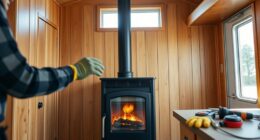Are you aware that employing a wood stove can lower your heating costs by as much as 30%?
In this article, I’ll show you how to operate a wood stove like a pro. From choosing the right wood to maintaining and cleaning your stove, I’ll guide you through each step with detailed instructions.
With proper ventilation and safe operation, you’ll be able to enjoy the cozy warmth and cost-saving benefits of your wood stove all winter long.
Let’s get started!

Key Takeaways
- Choose the right wood for your stove, such as hardwoods like oak, maple, and birch for longer burn time and more heat production.
- Properly prepare the firebox by cleaning out ash and debris, using newspaper or firestarter material, arranging kindling in a crisscross pattern, and stacking larger fuelwood on top for proper air circulation.
- Control the heat output with the damper by adjusting airflow to regulate oxygen entering the firebox, ensuring efficient burning and preventing overheating.
- Maintain and clean your wood stove regularly by sweeping ashes, inspecting and cleaning the chimney, checking the damper, and troubleshooting common issues for optimal performance and safety.
Choosing the Right Wood for Your Stove
I’m currently researching the best types of wood to use in my stove this winter. When it comes to storing firewood, it’s important to choose the right kind to ensure efficient burning and reduce smoke emissions.
Hardwoods like oak, maple, and birch are ideal choices as they’ve a higher density and longer burn time. These woods produce more heat and require less frequent loading.
Softwoods like pine and fir, on the other hand, have a lower density and burn faster. They can be used as kindling to start the fire but aren’t recommended for extended burning.
Preparing the Firebox and Igniting the Fire
To ensure a successful fire, I carefully arrange the kindling and fuelwood in the firebox, ensuring proper air circulation and ignition. First, I clean out any ash or debris from the previous fire. Then, I place a layer of crumpled newspaper or firestarter material at the bottom of the firebox. Next, I arrange small, dry kindling in a crisscross pattern on top of the newspaper. Finally, I stack larger pieces of fuelwood on top of the kindling, leaving enough space for air to circulate.
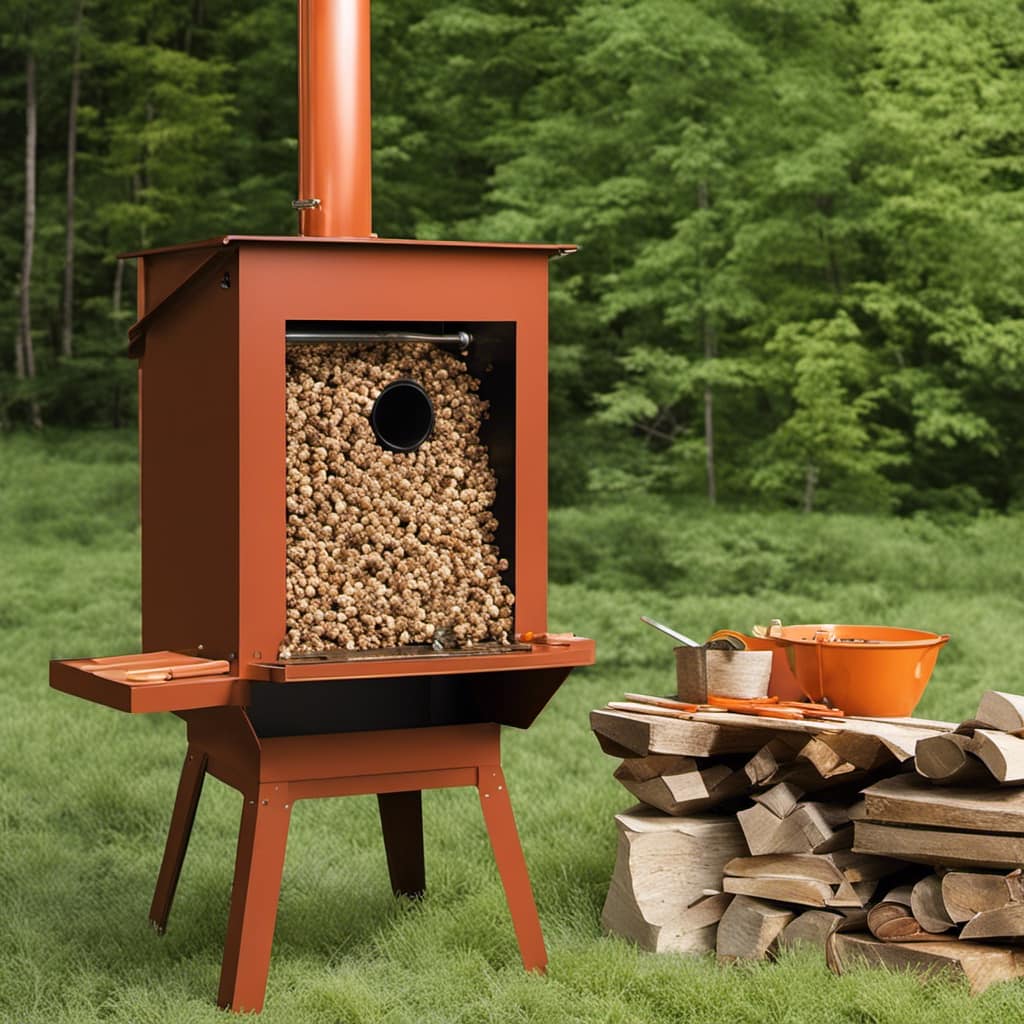
To make the writing more enjoyable and relatable, here is a handy table summarizing the steps:
| Step | Actions |
|---|---|
| 1 | Clean out ash and debris |
| 2 | Place newspaper or firestarter material at the bottom |
| 3 | Arrange small kindling in a crisscross pattern |
| 4 | Stack larger fuelwood on top, ensuring air circulation |
When it comes to igniting the fire, there are a few common issues that may arise. One of the most common issues is damp or wet firewood. It’s important to store firewood properly in a dry, well-ventilated area to avoid this problem. Another issue could be improper air intake or draft. Make sure the air vents are open and the chimney is clear of any obstructions. By following these steps and troubleshooting common ignition issues, you can enjoy a cozy and efficient fire in your wood stove.
Controlling the Heat Output With the Damper
While operating the wood stove, I can control the heat output by adjusting the damper to regulate the airflow. The damper plays a crucial role in maintaining the optimal temperature inside the stove.
By adjusting the damper, I can increase or decrease the amount of oxygen entering the firebox, thereby controlling the intensity of the fire and the heat produced. This is important because the airflow directly affects the combustion process.
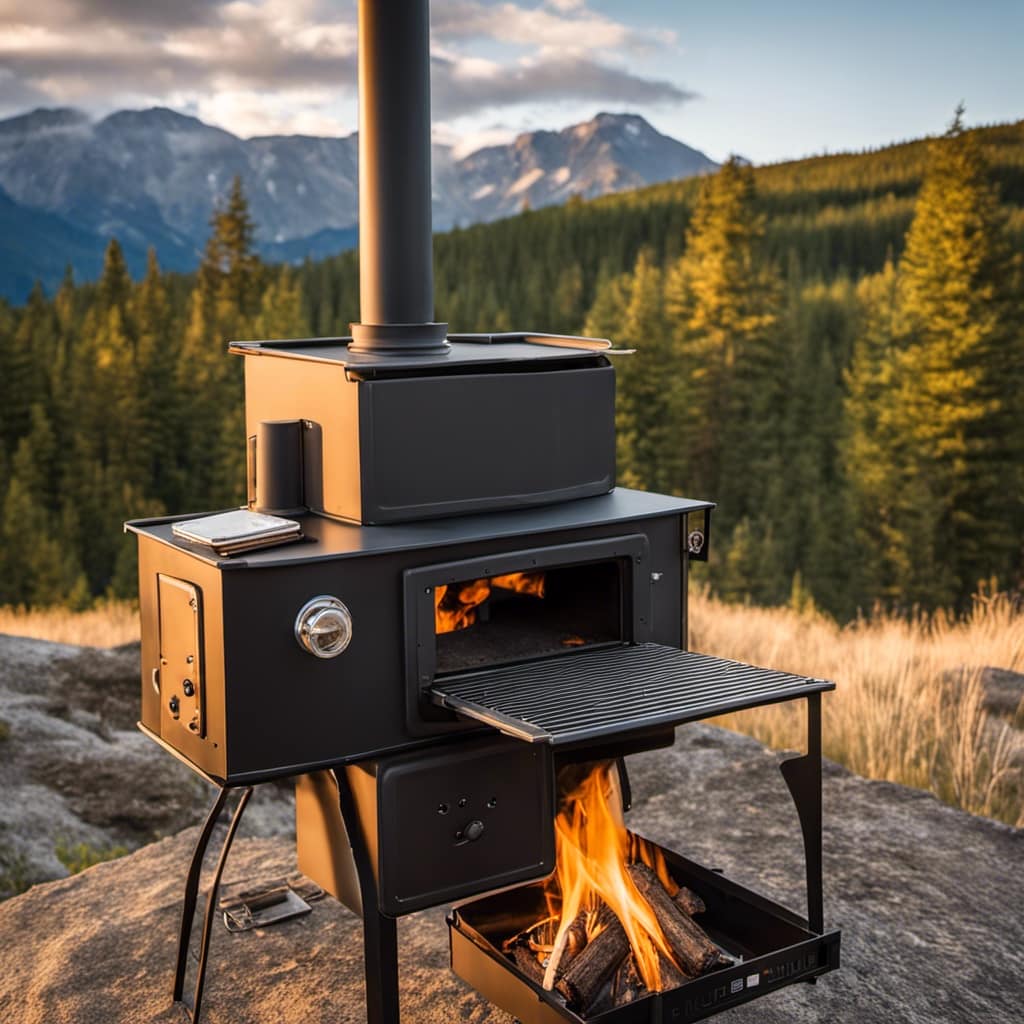
Sufficient airflow allows for efficient burning of the wood, resulting in a steady heat output. On the other hand, restricting the airflow reduces the oxygen supply, leading to a slower burn rate and lower heat output.
It’s essential to find the right balance by adjusting the damper to ensure maximum heat efficiency while preventing the stove from overheating.
Maintaining and Cleaning Your Wood Stove
I regularly sweep the ashes and debris from the firebox to maintain and clean my wood stove. Proper chimney maintenance is essential to ensure the safe and efficient operation of your wood stove. Here are some important steps to follow:
-
Inspect and clean the chimney regularly to remove any creosote buildup. This will prevent chimney fires and improve airflow.
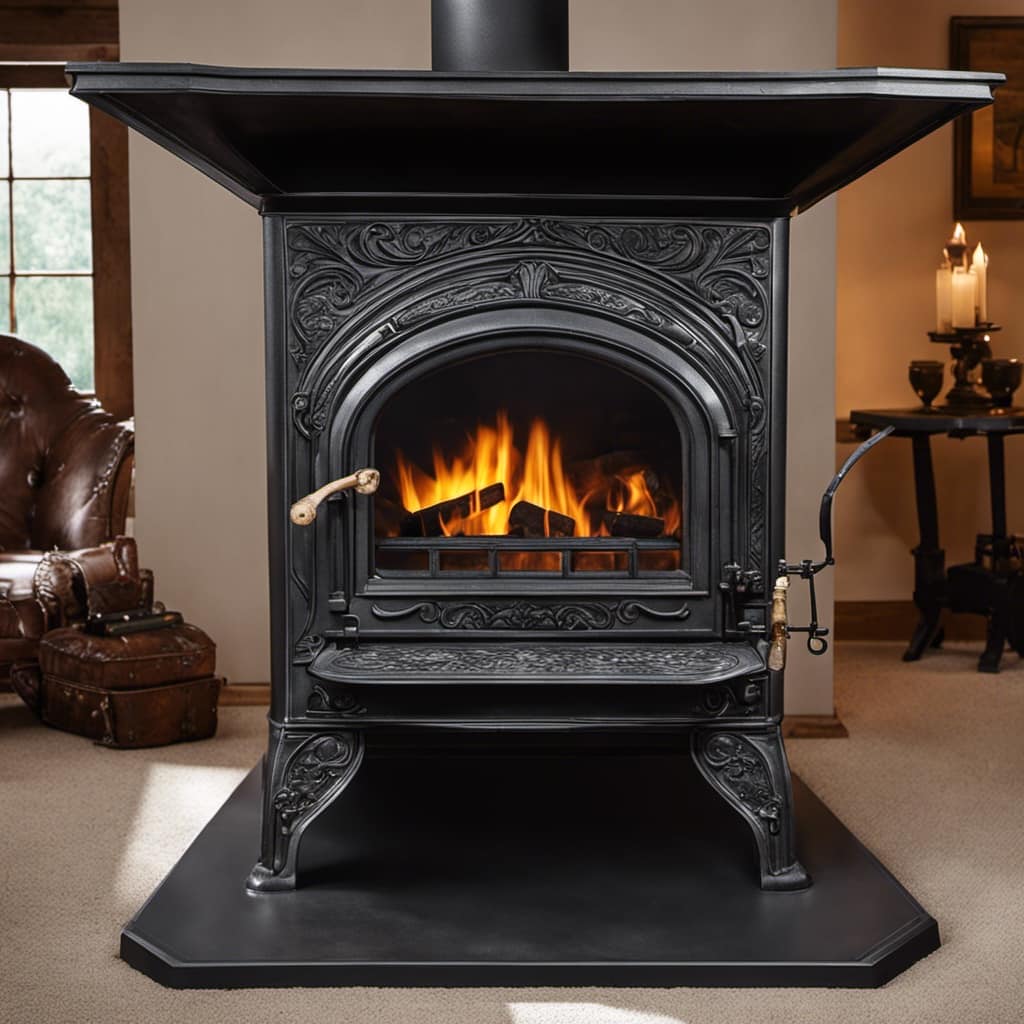
-
Check the chimney cap for damage or blockages. A damaged cap can allow rain or debris to enter the chimney, while a blockage can cause smoke to back up into your home.
-
Ensure the damper is working properly. A faulty damper can lead to poor combustion and excessive smoke.
-
Troubleshoot common wood stove issues such as a weak fire, excessive smoke, or difficulty in lighting. This may involve adjusting the air intake, checking the wood quality, or cleaning the stovepipe.
Ensuring Safe Operation and Proper Ventilation
I always make sure to check that my wood stove has proper ventilation to ensure safe operation. Ventilation is crucial when it comes to wood stoves, as it helps to prevent the buildup of harmful gases, such as carbon monoxide, and ensures efficient combustion.
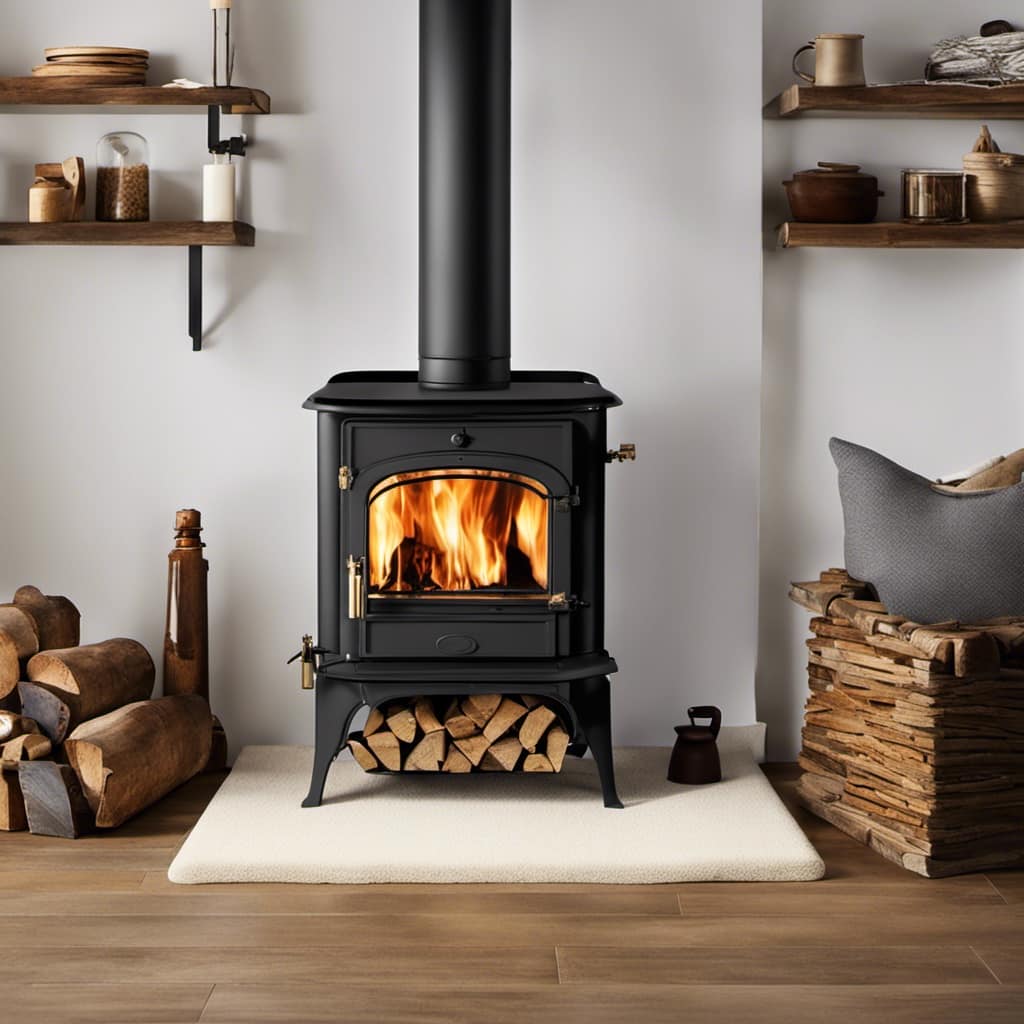
One of the key ventilation tips is to have a chimney that’s clean and free from any blockages. Regularly inspecting and cleaning the chimney is essential to avoid any potential hazards. Additionally, it’s important to have a damper that can be adjusted to control the airflow. This allows for better control of the fire and prevents the stove from getting too hot.
Safety precautions should always be taken, such as keeping flammable materials away from the stove and installing carbon monoxide detectors in your home. By following these ventilation tips and safety precautions, you can enjoy the warmth of your wood stove while ensuring the safety of your household.
Frequently Asked Questions
How Often Should I Clean the Chimney of My Wood Stove?
I clean the chimney of my wood stove at least once a year. It’s important to keep it clear of creosote buildup to prevent chimney fires. The best method is to hire a professional chimney sweep for a thorough cleaning.
Can I Use Softwood in My Wood Stove, or Should I Only Use Hardwood?
I prefer hardwood over softwood for my wood stove due to its higher energy content and longer burn time. Softwood tends to burn faster and produce less heat.
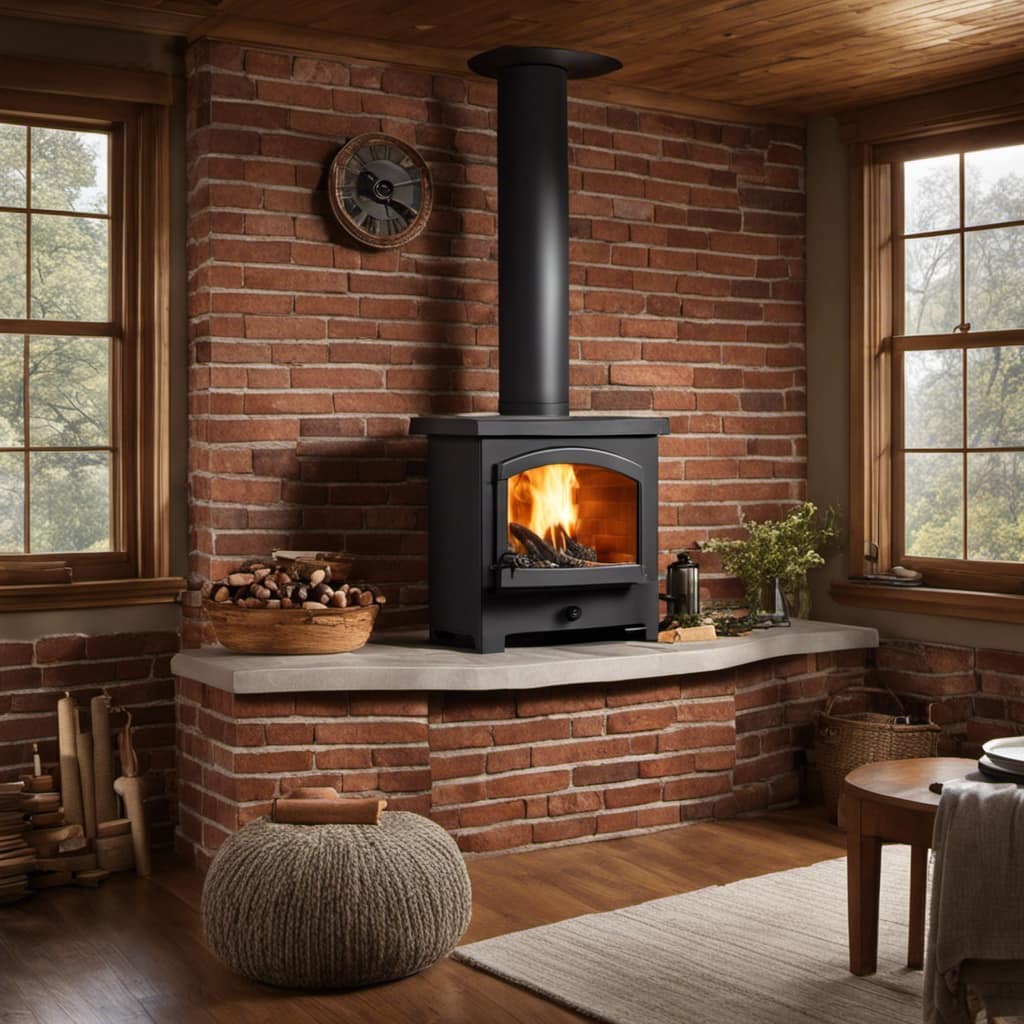
How Do I Know if My Wood Stove Is Properly Ventilated?
To know if my wood stove is properly ventilated, I look for signs like smoke leaking into the room, difficulty in starting or maintaining a fire, or excessive creosote buildup. These indicate improper ventilation and require immediate attention.
What Should I Do if Smoke Starts to Come Out of My Wood Stove When I Open the Door?
If smoke starts coming out of my wood stove when I open the door, it’s important to act quickly to ensure safety. Troubleshooting smoke issues and following safety precautions are crucial in operating a wood stove effectively.
Is It Necessary to Have a Fire Extinguisher Nearby When Operating a Wood Stove?
Yes, it is necessary to have a fire extinguisher nearby when operating a wood stove. Safety precautions should always be taken seriously to prevent accidents and ensure the well-being of everyone in the vicinity.
Conclusion
In conclusion, operating a wood stove requires careful attention to detail and knowledge of proper techniques.

By choosing the right wood, preparing the firebox correctly, controlling the heat output with the damper, and regularly maintaining and cleaning the stove, you can ensure safe operation and efficient heat production.
Remember, ‘practice makes perfect,’ so with time and experience, you’ll become a master of operating your wood stove.
So go ahead, cozy up by the fire and enjoy the warmth and ambiance it brings.
Growing up surrounded by the vast beauty of nature, Sierra was always drawn to the call of the wild. While others sought the comfort of the familiar, she ventured out, embracing the unpredictable and finding stories in the heartbeat of nature.
At the epicenter of every remarkable venture lies a dynamic team—a fusion of diverse talents, visions, and passions. The essence of Best Small Wood Stoves is crafted and refined by such a trio: Sierra, Logan, and Terra. Their collective expertise has transformed the platform into a leading authority on small wood stoves, radiating warmth and knowledge in equal measure.









